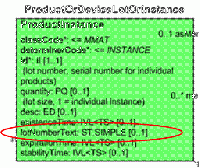Difference between revisions of "Deprecating Lot Number Text"
Julie James (talk | contribs) (Created page with "This is a process that was started at the CPM quarter at the San Antonio WGM January 2012. In CPM there is representation of '''an instance of a product''', using R_ProductInsta...") |
Julie James (talk | contribs) |
||
| Line 7: | Line 7: | ||
(b) a product lot, i.e., a set of things of the same kind (e.g., 1000 for expressing a number of tablets) or an amorphous mass (e.g., 100 L of a liquid raw material), or | (b) a product lot, i.e., a set of things of the same kind (e.g., 1000 for expressing a number of tablets) or an amorphous mass (e.g., 100 L of a liquid raw material), or | ||
(c) any subset, member, or portion of a product lot. The distinction between an individual thing and a lot is made in the quantity attribute, which is set to 1 (one) for individual items, or any number e.g., 1000 or amount 100 L for sets of things or amorphous masses respectively. | (c) any subset, member, or portion of a product lot. The distinction between an individual thing and a lot is made in the quantity attribute, which is set to 1 (one) for individual items, or any number e.g., 1000 or amount 100 L for sets of things or amorphous masses respectively. | ||
| + | |||
| + | [[Image:CPM_LotNumberText_Product_Instance.GIF|200px]] | ||
The entity that represents the product instance has the attribute lotNumberText, but this has the following design comments: | The entity that represents the product instance has the attribute lotNumberText, but this has the following design comments: | ||
<<DEPRECATED: The lot number for this instance. It identifies an amount of the product that has been produced or otherwise processed together. This attribute should NOT be used any more, as a product lot is represented as an instance of itself, and the individual (serialized) items, or sub-portions of the lot are represented as "members" of the lot instance.>> | <<DEPRECATED: The lot number for this instance. It identifies an amount of the product that has been produced or otherwise processed together. This attribute should NOT be used any more, as a product lot is represented as an instance of itself, and the individual (serialized) items, or sub-portions of the lot are represented as "members" of the lot instance.>> | ||
Revision as of 11:12, 7 February 2012
This is a process that was started at the CPM quarter at the San Antonio WGM January 2012.
In CPM there is representation of an instance of a product, using R_ProductInstance (POCP_RM020100UV). The text for the instance says: A product instance is (a) an individual product instance, i.e., an individually identified thing with a serial number; (b) a product lot, i.e., a set of things of the same kind (e.g., 1000 for expressing a number of tablets) or an amorphous mass (e.g., 100 L of a liquid raw material), or (c) any subset, member, or portion of a product lot. The distinction between an individual thing and a lot is made in the quantity attribute, which is set to 1 (one) for individual items, or any number e.g., 1000 or amount 100 L for sets of things or amorphous masses respectively.
The entity that represents the product instance has the attribute lotNumberText, but this has the following design comments: <<DEPRECATED: The lot number for this instance. It identifies an amount of the product that has been produced or otherwise processed together. This attribute should NOT be used any more, as a product lot is represented as an instance of itself, and the individual (serialized) items, or sub-portions of the lot are represented as "members" of the lot instance.>>
